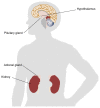Disturbances of the stress response: the role of the HPA axis during alcohol withdrawal and abstinence
- PMID: 15706736
- PMCID: PMC6761816
Disturbances of the stress response: the role of the HPA axis during alcohol withdrawal and abstinence
Abstract
Interactions among the brain, the pituitary gland, and the adrenal glands (i.e., the hypothalamic-pituitary-adrenal [HPA] axis) help regulate the body's response to stress. The adrenal hormone cortisol plays a key role in stress reduction through its effects on multiple body systems. Excessive cortisol activity during both chronic alcohol administration and withdrawal may underlie some of the clinical complications of alcoholism, including increased risk of infectious diseases; bone, muscle, and reproductive system changes; altered energy metabolism; and disorders of mood and intellect. Despite excessive cortisol levels during intoxication and withdrawal, however, the HPA axis becomes less responsive to stress during abstinence, potentially resulting in an impaired capacity to cope with relapse-inducing stressors.
Figures


Similar articles
-
Disturbances of hypothalamic-pituitary-adrenal axis functioning during ethanol withdrawal in six men.Am J Psychiatry. 1991 Aug;148(8):1023-5. doi: 10.1176/ajp.148.8.1023. Am J Psychiatry. 1991. PMID: 1853950
-
Hypothalamic-pituitary function during alcohol exposure and withdrawal and cocaine exposure.Recent Dev Alcohol. 1992;10:57-71. doi: 10.1007/978-1-4899-1648-8_3. Recent Dev Alcohol. 1992. PMID: 1317048 Clinical Trial.
-
Effects of alcohol dependence and withdrawal on stress responsiveness and alcohol consumption.Alcohol Res. 2012;34(4):448-58. Alcohol Res. 2012. PMID: 23584111 Free PMC article. Review.
-
Chronic daily ethanol and withdrawal: 1. Long-term changes in the hypothalamo-pituitary-adrenal axis.Alcohol Clin Exp Res. 2000 Dec;24(12):1836-49. Alcohol Clin Exp Res. 2000. PMID: 11141043
-
Stress and the HPA axis: role of glucocorticoids in alcohol dependence.Alcohol Res. 2012;34(4):468-83. Alcohol Res. 2012. PMID: 23584113 Free PMC article. Review.
Cited by
-
Induction of multiple reinstatements of ethanol- and sucrose-seeking behavior in Long-Evans rats by the α-2 adrenoreceptor antagonist yohimbine.Psychopharmacology (Berl). 2011 Nov;218(1):101-10. doi: 10.1007/s00213-011-2451-9. Epub 2011 Aug 24. Psychopharmacology (Berl). 2011. PMID: 21863233 Free PMC article.
-
Dyshomeostasis, obesity, addiction and chronic stress.Health Psychol Open. 2016 Mar 28;3(1):2055102916636907. doi: 10.1177/2055102916636907. eCollection 2016 Jan. Health Psychol Open. 2016. PMID: 28070396 Free PMC article.
-
Adrenocortical sensitivity, moderated by ongoing stress, predicts drinking intensity in alcohol-dependent men.Psychoneuroendocrinology. 2017 Feb;76:67-76. doi: 10.1016/j.psyneuen.2016.10.011. Epub 2016 Nov 5. Psychoneuroendocrinology. 2017. PMID: 27888772 Free PMC article.
-
Asoprisnil as a Novel Ligand Interacting with Stress-Associated Glucocorticoid Receptor.Biomedicines. 2024 Nov 30;12(12):2745. doi: 10.3390/biomedicines12122745. Biomedicines. 2024. PMID: 39767652 Free PMC article.
-
Communication networks in the brain: neurons, receptors, neurotransmitters, and alcohol.Alcohol Res Health. 2008;31(3):196-214. Alcohol Res Health. 2008. PMID: 23584863 Free PMC article. Review.
References
-
- Adinoff B, Risher-Flowers D, De Jong J, Ravitz B, Bone GHA, Nutt DJ, Roehrich L, Martin PR, Linnoila M. Disturbances of hypothalamic-pituitary-adrenal axis functioning during ethanol withdrawal in six men. American Journal of Psychiatry. 1991;148:1023–1025. - PubMed
-
- Adinoff B. The alcohol withdrawal syndrome: Neurobiology of treatment and toxicity. American Journal of Psychiatry. 1994;3:277–288.
-
- Chrousos GP. Regulation and dysregulation of the hypothalamic-pituitary-adrenal axis: The corticotropin-releasing hormone perspective. Neuroendocrinology. 1992;21:833–858. - PubMed
-
- Costa A, Bono G, Martignoni E, Merlo P, Sances G, Nappi G. An assessment of hypothalamo-pituitary-adrenal axis functioning in non-depressed, early-abstinent alcoholics. Psychoneuroendocrinology. 1996;21:263–275. - PubMed
-
- Deroche V, Marinelli M, Maccari S, Le Moal M, Simon H, Piazza PV. Stress-induced sensitization and glucocorticoids. I. Sensitization of dopamine-dependent locomotor effects of amphetamine and morphine depends on stress-induced corticosterone secretion. Journal of Neuroscience. 1995;15:7181–7188. - PMC - PubMed
Publication types
MeSH terms
Substances
LinkOut - more resources
Full Text Sources
